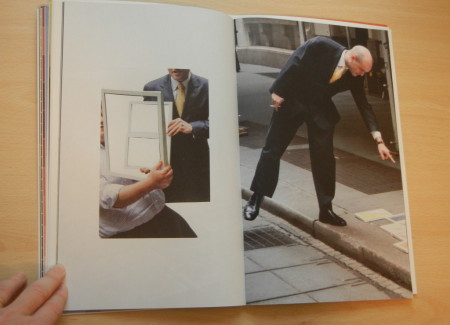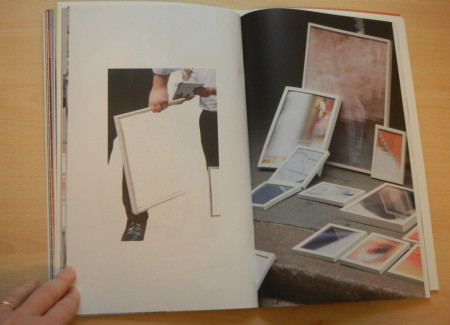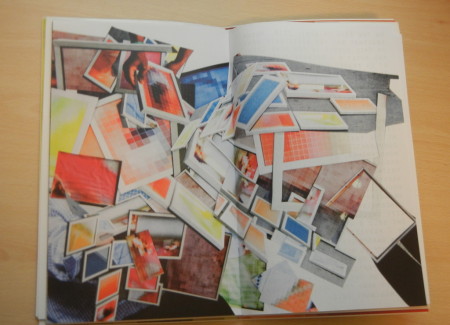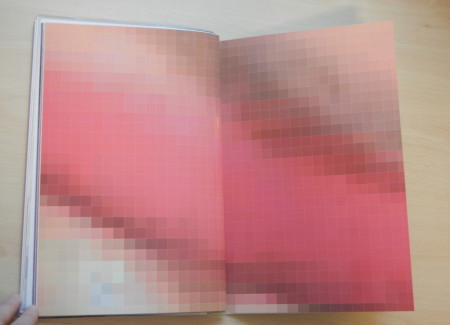JTF (just the facts): Published in 2013 by RVB Books (here). Softcover, loosely bound with a stapled insert, 100 pages, with 52 color photographs and photomontages. Includes a short explanatory text and a transcript of snippets of conversation from the project. (Spread shots below.)
Comments/Context: Anouk Kruithof’s Pixel-Stress is the kind of innovative, interdisciplinary project that is upending how we think about contemporary photography. Part Internet appropriation and rework, part public performance/installation, and part iterative photocollage, all wrapped up in an unconventional photobook form, it’s an exercise whose center lies at the confluence of these methods and forms, pushing and pulling on our expectations and definitions.
Kruitfhof began with a simple Google search for images related to “stress”, ultimately choosing 14 images which she appropriated, cropped and then enlarged to maximum size, turning the stock images of men and women staring at computer screens in head-in-hands disbelief into abstracted grids of pixelated color. These seas of morphing color were framed and brought out to the sidewalks of Wall Street, where she set up a makeshift installation under a temporary scaffolding and attempted to sell the works to bankers on their lunch breaks. Pictures of the interactions and transactions (she actually sold 8 of the prints, but then gave them to their buyers for free) were later further manipulated into a jittering set of after the fact photocollages.
Pixel-Stress collects all of this activity together into a single volume, but to call it a “book” would be a vast oversimplification of the formal originality it represents. Tiny thumbnails of the original “stress” images float on open white pages, the pixelated up close versions found on the backs in slippery high gloss. All of the works are then folded into a loose binder, held together by an elastic band; when you flip through the book, it comes apart in your hands. In the center, a stapled paper insert documents the sidewalk installation, complete with short quotes and reactions from the shoppers; the men in suits are then transformed into multiple image collages, where the pattern of a shirt collar or the splash of a pocket square is mixed together with the white frames and pixelated colors.
What is so satisfying about this project is that Kruithof’s layers of conceptual thinking aren’t brought together into some inscrutable art school obtuseness, but instead try to capture the essence of something inherently unphotographable, i.e. the complexities of stress. She brings together images of what the Internet thinks is stressful, how the bankers reacted to the works and defined their own stress, and how her performance itself had its elements of personal stress, moving back and forth, comparing and replaying. We might also conclude that the book itself is designed to cause the reader some stress, as it doesn’t function as we expect it to.
Kruithof’s approach isn’t to point her camera at something and tell us with plainspoken obviousness that “this is stress”; instead she offers a diverse set of interrelated data points, which she then uses to triangulate toward a more rounded expression. Along the way, she dissects different photographic modes, breaking them down and reassembling them to fit her artistic needs. That she could draw such nuance from such a seemingly simple construct is a testament to the impressively structured thinking going on here.
Collector’s POV: Anouk Kruithof is represented by Boetzelaer Nispen in Amsterdam (here). Her work has not yet reached the secondary markets, so gallery retail remains the best option for those collectors interested in following up.

















Sorry, Loring, you are going to kick my head in. There’s a lot of good things in your review but I’ve got to call you on this;
‘What is so satisfying about this project is that Kruithof’s layers of conceptual thinking aren’t brought together into some inscrutable art school obtuseness’.
OK, let me try and unpick a few things.
I don’t think there is any significance to blowing up to the maximum size in photoshop. 3200 per cent is inconsequential as the aesthetic judgement when it came to what appeared on the screen was what mattered; if a crop from the blow up looked good it was used, simple as that.
The sales pitching was described as ‘engaging a commercial gesture and condemning the scarcity of the city dwellers encounterings’. I think that refers to the cliche that people don’t talk to stangers much in the big city. Compared to the countryside, eh? Cliche alert.
The fact that ‘Kruitkof is not allowed to conduct monetary transactions’ is not explained. Is it any more than a gesture? Artists – like rock stars and actors – usually like to disguise natural avarice as it’s uncool. Unless she always gives her work away. She had two assistants accompanying her, were they unable to conduct monetary transactions on her behalf, too. Does this limitation apply to her gallery? This is so vague as to render its signficance fairly meaningless.
And how should we interpret giving prints away to those who have the capacity to buy, as compared to those who would naturally assume they couldn’t afford to buy?
What is the rationale behind the trajectory from a google search to abstract pixellation? The generation of familiar ‘paint chart’ pixellated images from any digital source would be equally viable, but the fact it stems from Google suggests an authenticity (compared to staging and photographing people acting stressed). In fact, decontextualised, the provenance of the original images actually remains highly dubious – they could even be stock images. Ultimately, in what way is the search term ‘stress’ embedded and functioning at the end of a long line of choices?
I’m not clear if the framed images were made into some sort of shack-structure. If so was this to implicate ‘Wall Street bankers’ in a process of unwary breaking up of ‘property’, and therefore a foreclosure metaphor, one of the obvious consequences of the financial crisis with its epicentre here. And as for those people who have faced foreclosure on their homes and who now live with their families for years in motels, I wonder if they have any thoughts on the subject of ‘stress’ or would like free pictures for their walls? Of course despite the location the buyers may or may not actually be bankers, they are just passersby (photographed with or without their permission, we don’t know) – they could easily be service workers.
I’m probably being hugely unfair about work that is smart looking, fun and arty. But like much super-intellectualised art it’s fairly incoherent at the end of the day. That’s OK, it can still be pleasurable – and this is – in the way it simply teases us with meaning. But claiming much more than that is over-stretching what is really inherent in the work and just misguidedly bigging it up. I think we need to learn to live with artists not being philosophers of the first rank – and question when did it become a key part of the job description?